Diabetes, a chronic medical condition affecting millions worldwide, is often accompanied by severe long-term complications, including chronic diabetic ulcers (CDU). These ulcers, characterized by their slow-healing nature, pose a significant health risk and social burden, potentially leading to amputations in diabetic patients. Globally, CDU’s prevalence has been estimated at 6.3%.
One of the key factors contributing to impaired wound healing in diabetic individuals is the hypoxic state of the wound due to vascular damage. Proper wound healing typically progresses through four stages: coagulation, inflammation, proliferation, and remodeling.
Recently, a study explored the potential of spinach extract to enhance wound healing in diabetic patients. Spinach, known for its high nutritional value, can be consumed raw or cooked and offers a variety of essential nutrients, including vitamins, minerals, and antioxidants.
Of particular interest is the role of glutamine, found in spinach extract, in reducing inflammation and promoting wound healing. Glutamine has been shown to decrease the activity of inflammatory markers and improve insulin signaling. Previous research also indicates that spinach possesses anti-inflammatory, antidiabetic, and wound-healing properties.
The Study
The study conducted at Shahid Beheshti University of Medical Sciences in Tehran, Iran, aimed to investigate the impact of spinach extract on diabetic wound healing. Researchers prepared aqueous and alcoholic spinach extract following standard protocols.
Seventy-two male Sprague–Dawley rats were divided into six groups, including diabetic and non-diabetic rats. These groups received different treatments, involving aqueous or alcoholic spinach extract. The study monitored ulcer regeneration, blood sugar levels, vascular endothelial growth factor, and weight changes at various intervals.
Study Findings
The results demonstrated that wound healing occurred faster in groups treated with spinach extract before ulcer induction (groups E and F), with significant progress observed by the fourteenth day. In contrast, the diabetic control group exhibited a much slower healing process, taking until the thirtieth day.
Groups that received spinach extract, whether aqueous or alcoholic, showed a higher rate of recovery compared to other groups. This accelerated healing was attributed to the presence of vitamins in spinach extract, which aid in fibroblast collagen deposition and epithelialization. Vitamin C, in particular, contributes to collagen production, fibroblast activity, and increased vascular density in wounds.
Additionally, vitamins K and E, found in spinach extract, play diverse roles in the wound healing process. The study suggests that various phytochemical compounds in spinach extract synergistically contribute to enhanced wound healing.
Notably, the preventive groups (E and F) experienced a substantial reduction in blood glucose levels, entering the non-diabetic range by the fourteenth day. Significant weight changes in diabetic rats were also observed on day twenty-one.
These findings shed light on the potential of spinach extract as a natural remedy to expedite wound healing in diabetic individuals, offering hope for improved management of diabetic ulcers and their associated complications. Further research is warranted to explore the full scope of spinach extract’s therapeutic benefits in wound healing.

